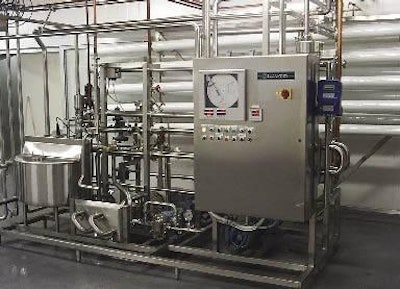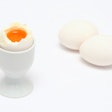
As the demand for liquid egg products increases, new processing technologies are being developed for the production of Extended Shelf Life (ESL) egg products. Until now, the most popular technology available for the production of ESL egg products has been “standard” time-temperature pasteurization processes. Using different time-temperature combinations, processing plants can achieve as much as 14 to 16 weeks of shelf life when storing the product at 4ºC (40ºF) or below. Today, it is still impossible to aseptically process natural liquid egg products due to the low coagulation temperature. By the time the required time and temperature minimums are achieved for the aseptic process, the egg products would be cooked.
Now, however, processes are under evaluation that not only rely on a time and temperature combination, but on additional non-temperature related factors that increase the kill rates achieved. These new technologies will offer different options for egg processors such as longer shelf life or the same shelf life with lower temperature-time combinations.
But it is—and it will always be—extremely important, regardless of the process, to use fresh, clean, washed, and sanitized eggs and to filter and chill them immediately after breaking in order to produce ESL products consistently. An egg in the shell can be considered sterile, which means that the bacteria we are trying to eliminate through the ESL processes come from egg breaking and collection.
The ideal ESL process would be to sterilize the shell before breaking it, and to break the egg under a tightly controlled environment to produce a raw product as close to sterile as possible. This will allow plants to process ESL egg products at less severe processing conditions, with reduced energy consumption and with minimal changes to product flavor and functionality.
What follows is a review of the different ESL processes, and new technologies.
Traditional Time and Temperature Process
A pasteurizer operates on a percentage basis: a 4 log means 99.99% reduction in bacteria, a 5 log 99.999%, a 6 log 99.9999%, etc. Egg processing plants have concentrated on finding ways to process egg products at the highest temperature possible and holding it for longer than the required minimum pasteurization time to achieve a longer shelf life.
The standard pasteurization system consists of four main components: a liquid handling system consisting of balance tanks, product and CIP pumps and valves; a heat exchanger, whether plate, tubular or a combination of both; holding tubes, where the pasteurization process takes place; and the control and recording systems. Through time, these components have been redesigned to allow the processing plant to achieve higher processing temperatures and a more uniform holding time.
Different combinations of heat exchangers have been tested to be able to process egg products at the required ESL temperatures for extended periods of time. The most efficient heat exchanger for food processing is the plate and frame system, but if not designed correctly, the product will start to coagulate on the plate surface, fouling the heat exchanger. Once the heat exchanger is fouled, it requires complete CIP (Clean-In-Place) cycle with the added time, energy, and chemical costs. This is the reason why some companies have installed either tubular heat exchangers or a combination of plate and tubular heat exchangers.
The tubular heat exchanger has a wider “opening” for the product, increasing the time the system can operate at an extended temperature before it has to be cleaned. But this same principle makes the heat transfer less efficient and the increased volume of the system more than doubles the chemical costs for cleaning.
The best option is a well designed plate heat exchanger that will allow plants to achieve the benefits of the tubular heat exchanger with higher heat transfer efficiency and reduced operating costs. A carefully designed heat exchanger will force the product to move at higher speeds on the critical sections of the system, maximizing product turbulence and reducing fouling, while at the same time protecting flavor and functional properties.
The holding tube is the most critical component of the system, and this is where efforts should be made to maximize its effectiveness and efficiency. This is the part of the system where the pasteurization process takes place and where the bacteria are killed by holding every particle of product for the required amount of time. Even if it sounds simple, the engineering of a holding tube can be rather complex.
There are two ways to guarantee that every particle of product is held for the required amount of time: Design the holding tube to be twice as long as required, or design a holding tube that eliminates the possibility of a laminar flow condition.
Knowing that the fastest particle in laminar flow condition moves at twice the speed of the average flow speed, and designing a holding tube twice as long as required will guarantee that even the fastest particle will receive the required treatment. But doing so will also keep the majority of the product at process temperature longer than required, generating additional flavor changes and damage to functional properties.
The other option is to design a holding tube that guarantees turbulent flow, but it is easier said than done. The amount of “turbulence” in a liquid can be measured using the Reynolds number. This number takes into account the cinematic viscosity and the speed of the liquid. The problem is that even though there is a threshold under which we know for sure the flow is laminar, there is no upper limit that guarantees turbulence. This means that when designing a holding tube, it is extremely important to consider the cinematic viscosities of all products to be processed as well as the speeds inside the tube. In some cases it might not be possible to use the same holding tube for all egg products.
One of the main limitations of the time-temperature process is that egg products have a time and temperature limit before the process damages functional properties, generates off-flavors, or coagulates portions of the product.
Shockwave Technology
A new process technology that harnesses the destructive forces of cavitation and converts them into heating and homogenizing energy is currently under evaluation. This system applies direct heat to liquids without the use of a heat transfer surface; and, because there is no heat transfer surface, the system can operate at high temperatures for extended periods of time.
As a liquid egg product passes through the system, it is subjected to “controlled cavitation.” Hundreds of thousands of microscopic cavitation bubbles are produced, and as they implode, energy is given off into the liquid egg products. This energy is harnessed for scale-free heating and microscopic mixing. The egg particles are mixed at the microscopic level, which increases the mass transfer rate for perfect homogenization.
This technology will allow processing plants to pasteurize egg products at the highest possible temperature without fouling the heat exchanger. And it will eliminate the need for tubular heat exchangers with the corresponding energy, water, and chemical savings.
Preliminary tests have shown that the microscopic shockwaves have also had an effect of bacterial reduction on dairy products not related to process temperature. It was found that they have an effect on the bacterial cell wall, without interfering with the carbon bonds of the proteins. This could benefit processing plants in more than one way: obtaining additional shelf life when processing at their current time and temperature combinations, or to reduce the time and temperature combination to achieve the same level of shelf life. This will reduce the operational costs as well as produce a product with better flavor and better functional properties.
Infusion
This system operates by holding products for a fraction of a second at very high temperatures before flash cooling. The product is preheated before entering the top of the infusion chamber where it is mixed with steam. Less than 0.2 seconds later, the product reaches the required UHT temperature and it’s held for a fraction of a second. Product is chilled as it reaches the bottom of the chamber. As a last step, the system uses a vacuum chamber to eliminate the water added when the product mixes with the steam.
The process of infusion has had a limited use on egg products and has been used on milk for about 10 years or maybe a little longer. The infusion systems were introduced for the aseptic milk processing industry, and the product processed with this system has the best flavor when compared to other aseptic processors. The reason that it has not been more widely used is the cost of the equipment, maintenance requirements, and operational cost.
Hot Pack
After processing, it is extremely important to pay close attention to the packaging since everything that was eliminated during pasteurization can be added back to the product during packaging, except the hot-pack process. This process has been widely used in other food processing industries and consists of packaging the food products at pasteurization temperature and holding the product packages in a water bath at process temperature for the required amount of time.
This process has proven to have exceptional shelf life with reduced operational costs, but it only works with a very limited size and type of packaging materials. The process has been used with egg products that have been concentrated and/or large amounts (up to 50%) of salt or sugar have been added. When these products are processed under specific time and temperature conditions, the product can be held up to 12 months at room temperature.














